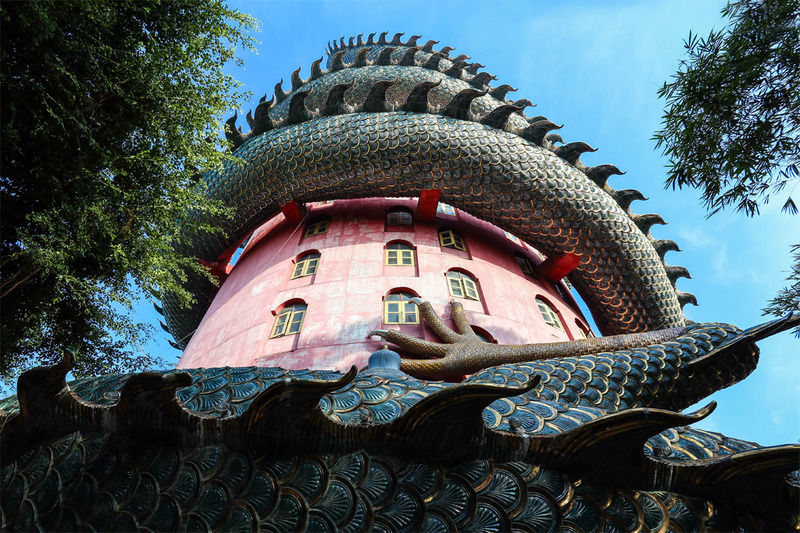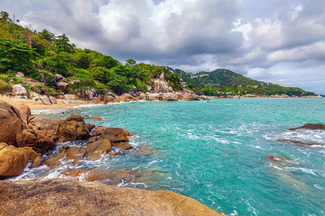WAT SAMPHRAN - THE DRAGON TEMPLE

If you like a good mystery then Wat Samphran, the Dragon Temple, may be the place to visit to examine the case in detail. Well off the tourist track, located about 40 kilometres from Bangkok in Amphoe Sam Phran in Nakhon Pathom province, this odd and unique temple, a mix of both Thai and Chinese design elements, is a visual delight and an intriguing architectural wonder of seemingly obscure origins.
Although the actual year the temple was built seems to be unknown today, it was officially registered in 1985. The founder of this temple is reputed to have been inspired to build the temple after a seven-day meditation and fast. Construction is said to have taken only five years and the temple was meant to be a place for monks to study and meditate but was never completely finished.
 In Thailand you are never far away from the Buddha serene gaze
In Thailand you are never far away from the Buddha serene gaze
This rose-pink temple tower is 17 storeys and rises to a height of 80 metres, which is the reputed age of the Buddha at the time of his death. From the ground floor a giant green Dragon coils it way upwards to the roof to gaze out over the plains below, and is quite obviously the temple’s most distinctive feature, but the reason for the encircling dragon is today unknown.
 Caught in the dragon’s embrace
Caught in the dragon’s embrace
The dragon’s body is hollow and it is possible to make the ascent through a tunnel inside, though few people do. The dragon’s five claws are said to be a symbolic reminder of the five moral precepts in Buddhism.
Once you have reached the end of the tunnel at the top of the tower you’ll find the ‘Happiness’ sculpture, a gift to the founding monk, meant to remind worshipers that the path to happiness lies in compassion and gratitude.
 The white rabbit sits in the temple grounds
The white rabbit sits in the temple grounds
In the grounds of the temple are a number of animal statues, a massive elephant, a white rabbit, a pod of dolphins and some tigers and a ship that appears out of nowhere. There is also a large turtle through which visitors can walk that leads to a small pond.
The temple and its grounds are wonderfully tranquil and mostly devoid of people. The few visitors that you do see are usually Thai as the temple remains largely unknown to tourists, which is a shame as this striking building deserves to be better known and appreciated and the revenue from any increased tourist traffic could be used to maintain this sorely neglected architectural marvel for future generations.
There is something intrinsically Thai about this temple, with its deep reverence for Buddhist precepts and iconography, but with wonderfully whimsical nuances all vaguely redolent of the often bizarre and beguiling incongruities that make Thailand such an interesting place to explore.










of collaborative energy




Before proceeding to use the website please carefully ready our Terms and Policies
I accept Diwerent's Terms and Conditions and Privacy Policy













